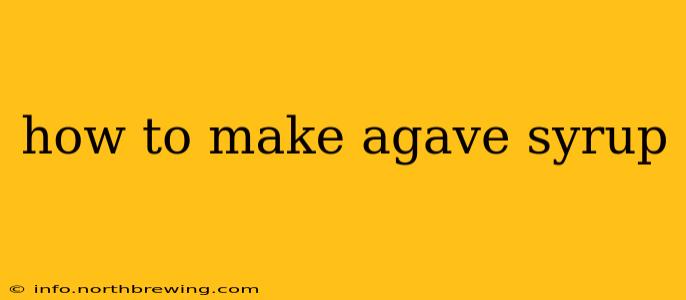Agave syrup, a popular natural sweetener, is increasingly sought after for its mild flavor and high fructose content. While readily available commercially, making your own agave syrup at home offers a rewarding experience and allows for greater control over the ingredients and process. This comprehensive guide will walk you through the steps, answering common questions along the way.
What is Agave Syrup?
Agave syrup is a natural sweetener derived from the agave plant, primarily the blue agave ( Agave tequilana). Unlike refined sugars, agave syrup retains some of the plant's natural nutrients and minerals. Its sweetness comes predominantly from fructose, a simple sugar that is quickly absorbed by the body.
What You'll Need to Make Agave Syrup
Unfortunately, making agave syrup from scratch at home isn't as simple as juicing fruit. The process requires specialized equipment and techniques typically found in industrial settings. You won't be able to make it from raw agave plants using common household appliances. The process involves:
- Mature Agave Hearts: These are the core of the agave plant, containing the highest concentration of sugars. Accessing these requires harvesting mature plants, a process best left to experienced agave farmers.
- Industrial-Grade Equipment: This includes specialized ovens for cooking the agave hearts, and presses for extracting the juice. Fermentation and filtration processes also require specialized tools.
Can I Make Agave Syrup at Home Using a Blender or Juicer?
No, you cannot make true agave syrup at home using a blender or juicer. The process requires extensive cooking and extraction methods far beyond the capabilities of home kitchen appliances. Agave hearts are tough and fibrous, requiring industrial-strength equipment to efficiently extract the sugary juice. Attempting to process them at home would be ineffective and likely dangerous.
What are the Steps Involved in Commercial Agave Syrup Production?
The commercial production of agave syrup involves several crucial steps:
- Harvesting: Mature agave plants are harvested, and their hearts (piñas) are carefully extracted.
- Cooking: The agave hearts are cooked in large ovens to break down the complex sugars into simpler forms.
- Extraction: The cooked agave is pressed to extract the sweet juice.
- Filtration: The juice is filtered to remove impurities.
- Evaporation: The juice is carefully evaporated to concentrate the sugars and create the syrup consistency.
- Packaging: The finished agave syrup is packaged and distributed.
Is Making Agave Syrup at Home Economically Feasible?
No, making agave syrup at home is not economically feasible. The cost of acquiring mature agave hearts, along with the specialized equipment required, significantly outweighs the cost of purchasing commercially produced agave syrup.
What are the Health Benefits and Considerations of Agave Syrup?
While agave syrup offers a natural sweetness, it's crucial to remember that it's still high in fructose. Excessive fructose consumption can negatively impact health, potentially contributing to weight gain, metabolic issues, and liver problems. Moderation is key when incorporating agave syrup into your diet. Always check the nutritional information on the label of commercially produced agave to understand its specific composition.
Conclusion
While the allure of making your own agave syrup might be tempting, the reality is that it's a complex industrial process requiring specialized equipment and expertise. Focusing on sourcing high-quality, commercially produced agave syrup while consuming it in moderation is a far more practical and safe approach.
